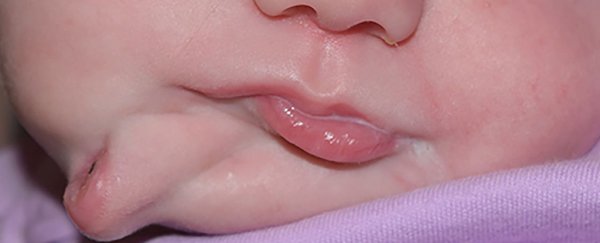Countless biological processes are involved in growing a mini human, and sometimes parts of this complex life's miracle can go awry. So we scan and test babies as they develop to prepare for anything out of the ordinary… although the growth of a second mouth isn't usually on the cards.
During one such scan of a baby in its third trimester, doctors detected an unusual mass to the right of the baby's mouth. (Warning: slightly graphic photo ahead.)
But the prenatal ultrasonography did not allow the team to resolve what exactly they were looking at. Possibilities included a cyst, fibrous dysplasia or a teratoma, which can occur when one twin absorbs another during development.
Once the girl was born, it became apparent the mass was actually a small second mouth. It had its own lip, cavity, teeth and a tiny little tongue that moved in synchrony with her main tongue as she fed.
 Patient's second tongue prior surgery. (Hamberis et al., BMJ Case Reports, 2020)
Patient's second tongue prior surgery. (Hamberis et al., BMJ Case Reports, 2020)
Occasionally, the skin around this second mouth would develop a "raw surface", doctors from the Medical University of South Carolina noted in their case report, and would drain a clear fluid that they suspected was saliva.
Luckily for this baby girl, the extra oral cavity did not appear to cause any problems with her breathing or ability to feed. It did not even connect to her central mouth, which appeared to function normally.
Diprosopus - the duplication of head and/or facial structures - is a very rare condition, with only around 35 cases on record in humans since 1900. At its extreme, this condition can lead to a full facial duplication, like this example in a cat. But when it comes to duplications involving just one area of the face, it's usually the mouth parts that are involved.
This condition occurs more often in females, but no one knows why.
"Duplication of craniofacial structures typically occurs as part of a syndrome and is often associated with cleft lip and cleft palate, Klippel-Feil syndrome and Pierre Robin sequence," the doctors explained in their case report.
"Our patient's craniofacial duplication is a rare case that presented as an isolated anomaly, with no associated syndromes or abnormalities."
This allowed the doctors to perform surgery to remove the extra month when the girl was just six months old. In total, they removed some muscle, bone, mouth mucous membrane and oesophagus tissue, as well as a salivary gland and six unerupted teeth, all while carefully trying to preserve her facial nerves.
Other than some swelling at the surgical site, which resolved after several months, the patient healed well and required no further treatment. The doctors noted she has trouble relaxing the right part of her lower lip, possibly due to some missing nerves.
 The patient one month after surgery. (Hamberis et al., BMJ Case Reports, 2020)
The patient one month after surgery. (Hamberis et al., BMJ Case Reports, 2020)
Diprosopus can arise as a form of conjoined twins or possibly through the duplication of a structure called a pharyngeal arch that forms during the fourth week of human embryo development. The first of these six arches grow into the bones and muscles of our jaws, and parts of the tongue, among other things.
However, the team does not believe the pharyngeal arch theory explains this case, as the other structures this arch forms were all normal. As you can see, there is still a lot unknown about this rare condition - and every single case we record is a medical wonder.
This research was published in BMJ Case Reports.
